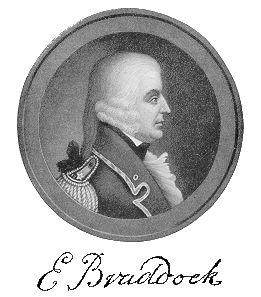Part of a series of articles titled French and Indian War - The Contest for the Ohio River Valley .
Previous: Battle of Fort Necessity
Article

After George Washington's defeat at Fort Necessity, his British force retreated to Wills Creek (present day Cumberland, Maryland).
The March to the Forks
After appeals from colonial governors, the British decided to take matters more seriously and sent Major General Braddock to North America with two regiments of infantry. Braddock, a career soldier, had risen through the ranks. After 45 years of military service he became commander-in-chief of all British forces in North America. The British plan for 1755 was to simultaneously attack many French forts in North America. Braddock would lead the expedition against Fort Duquesne personally. That spring, he disembarked his army at Alexandria, Virginia. After adding colonial troops and a few Indians to his force, Braddock had about 2,400 men. George Washington joined the campaign as a volunteer aide to the General.
Braddock Road
The army assembled at Wills Creek. Braddock decided to follow the road Washington had blazed over the mountains on his way to Fort Necessity the previous year. Because the trail was inadequate for the army's large wagons and artillery, it was widened to 12 feet, but only at great effort and expenditure of time. The force seemed to move at a snail's pace. Finally the army was split in two with Braddock moving ahead with the bulk of the men and a few pieces of artillery. The remainder would follow under the command of Colonel Dunbar
In early July, the advance group was approaching the Forks of the Ohio. On July 9, they made a second crossing of the Monongahela River. From that point it was a short march to Fort Duquesne.
The Battle of the Monongahela
Soon after the river crossing, the woods in front of the British column exploded with musket fire and the whooping of American Indians and their French allies as they collided head-on with the British. Advance British units fell back upon the main body, while the rear units continued advancing, adding to the confusion. Disorganization and fear seized the British. In the smoke of the battle, fighting an unseen enemy, and with many British officers killed early on, discipline all but ended.
The Battle lasted three hours. Finally, as Braddock was carried from the field severely wounded, the surviving British began to retreat. British losses had been horrendous: more than 900 casualties out of 1,400 men engaged. They were completely beaten by a force they could not see in a wilderness where they did not want to be. Their retreat to the safety of Dunbar's camp was hasty and disorganized. Washington reported "The shocking Scenes which presented themselves in this Nights March are not to be described. The dead, the dying, the groans, lamentations, and crys ... of the wounded for help were enough to pierce a heart of adamant".
The General is Buried
On July 13 The British camped about one mile west of the Great Meadows, site of Fort Necessity, and in the evening Braddock died. Washington officiated at the ceremony the next day. The general was buried in the road his men had built. The army then marched over the grave to obliterate any traces of it and continued to eastern Pennsylvania.One can only imagine what went through the general's mind after the battle. He commanded what some considered an invincible army. They were not ambushed, but rather surprised, and discipline broke down. The rout was a disgrace. Doctors later reported that the general had died more from anxiety than from his wounds.
Washington later wrote "...Thus died a man, whose good and bad qualities were intimately blended. He was brave even to a fault and in regular Service would have done honor to his profession. His attachments were warm, his enmities were strong, and having no disguise about him, both appeared in full force."
more on Braddock's Grave...
where to find traces of Braddock's Road...
The French used this British retreat to their advantage, and soon French-inspired Americna Indian attacks occurred throughout the frontier. Terrorized settlers streamed eastward and the war spread. In the ensuing decade, however, France lost all her colonies in North America and the British Empire was expanding around the globe. The removal of external threats to colonist and the increased cost of governing the British Empire helped set the stage for the American Revolution.
Part of a series of articles titled French and Indian War - The Contest for the Ohio River Valley .
Previous: Battle of Fort Necessity
Last updated: May 8, 2024